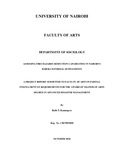| dc.description.abstract | Droughts, fires, flood, terrorism, technological accidents, diseases dominate Kenya’s disaster
profile and epidemics that disrupt people’s livelihoods, destroy the infrastructure, divert planned
use of resources, interrupt economic activities or retard development. Over the past few years,
Kenya has made progress in relation to disaster response and recovery, but not much in disaster
reduction. The severity and frequency of recurrent ‘everyday’ urban risks experienced
predominantly by socio-economically deprived residents in sprawling Kibera Slums have been
largely under-researched, or accorded little attention by disaster risk specialists in Kenya and
beyond.
The broad objective was to assess the fire hazards reduction capabilities in Nairobi’s Kibera
informal settlement. The study further sought to achieve the following specific objectives: to
investigate how fire hazards are managed by the Kibera residents internally vis-à-vis externally
by other actors; to investigate prospects for long-term strategies of fire hazard reduction that will
bring sustainable solutions and incorporate disaster resilience and mitigation into actions and
decisions; and to assess the level of capacity to reduce fire-related hazards among the residents
of Kibera Slums.
The study was carried out at within Kibera Slums. This study adopted a case study design. The
unit of analysis was the household. The unit of observation was the individual heads of
household. A field study was conducted covering 198 households’ heads and select key
informants. Simple random sampling method was used in the selection of individuals to be
interviewed. The study used interviewing as the principal data collection technique. The main
tools of data collection were structured interview schedules for key informants and household
heads.
v
The findings established that Kibera residents manage fire hazards using a two-pronged
approach. First, hazards are managed at the household level. Second, hazards are managed at the
community level which involves the immediate neighbourhood and other external actors. , the
findings revealed a range prospects for long-term strategies of fire hazard reduction that will
bring sustainable solutions and incorporate disaster resilience and mitigation into actions and
decisions for Kibera residents. These include: assistance from external actors; communication
and early warning approaches; sensitization on personal and household safety measures; and
comradeship. The study was able to reveal the level of capacity to reduce fire-related hazards
among the residents of Kibera Slums. The capacities were explored on the basis of three broad
categories namely: responsible handling of fire sources, institutional support, equipment, and
social networks. In order to enhance fire hazards reduction capabilities in Nairobi’s Kibera
informal settlement, the study recommended that the government should boost its external
support on preparedness; increase the level of awareness on fire hazards management among the
members of the community; and introduce measures to reduce the level of dependency by the
community to external interventions. This will be achieved through participatory decision-making | en_US |

